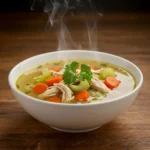Introduction
Tired of watery, flavorless chicken noodle soup that tastes more like dishwater than comfort food? You’re not alone. Most home cooks struggle with creating that perfect bowl of soul-warming goodness that actually delivers on flavor and satisfaction.
This classic chicken noodle soup recipe creates a rich, golden broth packed with tender chicken, perfectly cooked vegetables, and hearty egg noodles that won’t turn to mush. Every spoonful delivers the comforting taste you crave, ready in just 45 minutes from start to finish.
As a culinary instructor who’s taught thousands of students the art of soup-making over the past 12 years, I’ve perfected this foolproof method that eliminates common pitfalls like tough chicken, soggy noodles, and bland broth. This recipe has become my students’ most requested dish for good reason.
In this comprehensive guide, you’ll discover the secret to building deep flavor quickly, learn which chicken cuts deliver the best results, master the timing for perfect noodles, and get pro tips that transform ordinary ingredients into extraordinary comfort food. Plus, I’ll share storage hacks and variations to keep this recipe exciting meal after meal.
Table of Contents

Why This Chicken Noodle Soup Recipe Works
• Uses affordable, easy-to-find chicken cuts – Bone-in thighs provide maximum flavor without breaking the budget • Builds rich broth in 30 minutes instead of hours through layered seasoning techniques
• Perfect for meal prep or feeding a crowd – Makes 8 generous servings that freeze beautifully • Foolproof timing system prevents mushy noodles and overcooked vegetables • One-pot simplicity minimizes cleanup while maximizing flavor development
Choosing the Right Chicken
The foundation of exceptional chicken noodle soup starts with selecting the right cuts and understanding how each contributes to your final dish.
Best Cuts for This Recipe
The bones release gelatin during cooking, creating that signature rich mouthfeel, while the dark meat stays incredibly tender even with longer cooking times. The skin adds essential fat for flavor development.
Chicken breast and thigh combination offers the best of both worlds – breast meat for those who prefer white meat texture, and thighs for depth of flavor.
Whole chicken cut into pieces provides the most economical option and allows you to use every part. The back and wings contribute extra gelatin, while legs and thighs add richness.
Buying Tips
Look for chicken with pale pink color and no gray spots or strong odors. The skin should feel slightly tacky but not slimy.
Ask your butcher to cut a whole chicken into 8 pieces if you’re uncomfortable doing it yourself. They can also recommend the freshest cuts available that day.
For organic or free-range options, the investment pays off in superior flavor, especially in a simple preparation like soup where the chicken quality really shines through.
Substitutions
Turkey thighs work wonderfully as a substitute, though they’ll need an extra 10-15 minutes of cooking time. The flavor profile shifts slightly earthier but remains delicious.
Rotisserie chicken can be used for ultra-quick preparation – add the meat in the final 10 minutes to prevent overcooking, and use the bones to make a quick stock if desired.
Chicken drumsticks are budget-friendly and add great flavor, though they’re messier to eat in soup form – better suited when you plan to shred all the meat.
Ingredients & Prep
Chicken Prep Essentials
Pat the chicken completely dry with paper towels before you season it. Moisture prevents proper browning, which is crucial for developing the flavor base of your soup.
Season generously with salt at least 15 minutes before cooking, or up to 4 hours in advance. This dry-brining process helps the chicken retain moisture and enhances flavor throughout.
Trim excess skin and fat but don’t remove it entirely – you want some fat for flavor, but large pieces can make the soup greasy. A pair of kitchen shears makes this job quick and precise.
Aromatics and Seasonings
Classic mirepoix forms the vegetable base: 2 cups diced onions, 1 cup diced carrots, 1 cup diced celery. Cut all pieces roughly the same size to ensure they cook evenly.
Fresh herbs make a significant difference – use fresh thyme, parsley, and bay leaves when possible. Dried herbs work but add them earlier in the cooking process to allow time for rehydration.
Quality chicken stock elevates the entire dish. If you’re using store-bought ingredients (like broth or stock), always opt for low-sodium varieties. This allows you to control the overall salt level in your dish more precisely. Bone broth adds extra richness if you can find it.
Pantry Staples
Wide egg noodles are traditional, but medium-width works too. Avoid thin noodles that break apart easily. Fresh pasta cooks faster but dried gives better texture for reheating.
Neutral oil with high smoke point like vegetable or canola oil for browning the chicken. Olive oil can work but may impart too strong a flavor.
Acid component such as lemon juice brightens the finished soup – add just a teaspoon at the end for balance.
Step-by-Step Cooking Instructions
Follow this systematic approach to build layers of flavor while maintaining perfect timing for each component.
Pre-Cooking Prep
Bring chicken to room temperature by removing from refrigerator 30 minutes before cooking. Adding cold chicken to hot oil will quickly reduce the oil’s temperature, which in turn prevents proper browning. This is why it’s always best to let your chicken come to room temperature before cooking.
Prepare your mise en place by chopping all vegetables and measuring seasonings. Once you start cooking, things move quickly and you won’t have time to stop and chop.
Building the Flavor Base
Don’t overcrowd the pan – this creates steam instead of the browning reaction you want. Each piece should sizzle when it hits the oil.
Remove chicken and sauté aromatics in the same pot with the rendered chicken fat. Cook onions, carrots, and celery for 5-7 minutes until softened and lightly caramelized.
Simmering and Assembly
Return chicken to pot and add enough stock to cover by 2 inches. Bring to a gentle simmer – not a rolling boil, which will make the chicken tough and the broth cloudy.
Simmer partially covered for 25-35 minutes until chicken is fully cooked and tender.

Final Assembly
Remove chicken pieces and let cool slightly before shredding or cutting into bite-sized pieces. Discard bones and skin unless you prefer to leave some skin on for richness.
Strain the broth through a fine-mesh sieve if desired for a cleaner soup, or leave as-is for a more rustic texture.
Cook noodles separately in salted water according to package directions, then add to individual bowls. This prevents the noodles from continuing to absorb liquid and becoming mushy.
Pro Tips for Perfect Chicken Noodle Soup
These professional techniques separate good soup from extraordinary soup, addressing common problems before they occur.
Avoiding Common Mistakes
Never boil the soup vigorously once the chicken is added. Rapid boiling creates a cloudy, less appealing appearance and can make proteins tough.
Don’t add noodles directly to the pot if you plan to store leftovers. Cooked noodles continue absorbing liquid and become mushy. Instead, cook them separately and add to individual servings.
Taste and adjust seasoning at multiple stages. The soup will concentrate as it simmers, so season conservatively early on.
Essential Tool Recommendations
Large, heavy-bottomed Dutch oven distributes heat evenly and prevents scorching. A 6-8 quart size handles family portions comfortably.
Fine-mesh skimmer removes foam and impurities that rise to the surface during simmering, resulting in clearer, cleaner-tasting broth.
Instant-read thermometer ensures chicken reaches safe internal temperature of 165°F without overcooking. This is especially helpful for bone-in pieces where doneness is harder to judge visually.
Storage and Reheating
Cool soup quickly by placing the pot in an ice bath or transferring to shallow containers.
Freeze portions without noodles for up to 3 months. Add freshly cooked noodles when reheating for best texture.
Reheat gently over medium-low heat, stirring occasionally. Add additional stock if the soup has thickened too much during storage.
Flavor Variations
Transform your basic chicken noodle soup recipe into exciting new variations that cater to different tastes and dietary preferences.
International Twists
Asian-Inspired Version incorporates fresh ginger, garlic, soy sauce, and sesame oil.
Mexican-Style Soup adds cumin, chili powder, and diced jalapeños to the base. Use hominy instead of noodles and finish with fresh cilantro, lime juice, and diced avocado.
Italian Influence includes fresh basil, oregano, and a Parmesan rind simmered in the broth.
Dietary Adaptations
Keto-Friendly Version omits noodles entirely and adds extra vegetables like zucchini noodles, cauliflower florets, or shiitaki mushrooms for substance without carbs.
Gluten-Free Option substitutes rice noodles, corn pasta, or gluten-free egg noodles. Always check your stock and seasonings for hidden gluten sources.
Dairy-Free Preparation focuses on building richness through proper browning and bone-in chicken rather than cream additions. Coconut milk can add richness if desired.
Seasonal Variations
Spring Version incorporates fresh peas, asparagus tips, and baby spinach added in the final minutes of cooking. Fresh dill replaces some of the parsley for a brighter flavor profile.
Fall Comfort Style adds roasted butternut squash cubes and warming spices like sage and nutmeg. Sweet potato can substitute for some of the regular carrots.
Winter Hearty Version includes root vegetables like parsnips and turnips, plus heartier herbs like rosemary and thyme for a more robust flavor.
Serving Suggestions
Elevate your chicken noodle soup experience with thoughtful accompaniments and presentation ideas that turn a simple meal into something special.
Perfect Pairings
Crusty artisan bread or homemade biscuits provide the ideal vehicle for soaking up every drop of that precious broth. Warm them in the oven just before serving for maximum impact.
Simple green salad with lemon vinaigrette offers a fresh contrast to the rich, warming soup. Keep it light – just mixed greens, cucumber, and a bright dressing.
Presentation Tips
Warm your bowls in a low oven for a few minutes before serving. This keeps the soup hot longer and shows attention to detail that guests will notice.
Garnish thoughtfully with fresh chopped parsley, a sprinkle of black pepper, or a small dollop of sour cream for visual appeal and added flavor.
Serve family-style with the soup pot as a centerpiece, allowing people to help themselves and creating a cozy, communal atmosphere.

Frequently Asked Questions
Can I use frozen chicken for this recipe?
Yes, but thaw it completely first for food safety and even cooking. Frozen chicken won’t brown properly and can lower the oil temperature, affecting the flavor development. If you’re short on time, use the cold water thawing method – submerge sealed chicken in cold water, changing the water every 30 minutes.
How do I fix oversalted soup?
Add a peeled, quartered potato to the pot and simmer for 15 minutes – it will absorb excess salt. Remove before serving. You can also dilute with additional unsalted stock if the soup is too concentrated.
Is this recipe safe during pregnancy?
Yes, as long as the chicken reaches an internal temperature of 165°F and you use pasteurized ingredients. Pregnant women should avoid homemade stock that’s been sitting out or improperly stored. When in doubt, use store-bought, low-sodium chicken broth from a reputable brand.
How long does homemade chicken noodle soup last?
Without noodles, the soup base can be frozen for up to 3 months. Always reheat to steaming hot (165°F) before serving leftover soup.
What’s the best way to shred the chicken?
Let cooked chicken cool just enough to handle safely, then use two forks to pull the meat apart along the natural grain. For faster results, use clean hands to break the meat into bite-sized pieces. Remove any cartilage or small bones as you go.
Conclusion
Ready to create the most comforting, soul-warming chicken noodle soup your kitchen has ever produced? This foolproof recipe delivers restaurant-quality results in just 45 minutes, transforming simple ingredients into liquid gold that soothes both body and spirit.
The combination of proper browning techniques, quality ingredients, and careful timing creates a soup that’s worthy of your family recipe collection. Whether you’re nursing someone back to health, warming up after a cold day, or simply craving the ultimate comfort food, this chicken noodle soup recipe delivers every single time.
Join over 12,000 home cooks who’ve made this recipe their go-to comfort food solution! Share your results and variations in the comments below – I love seeing how you make this recipe your own.



